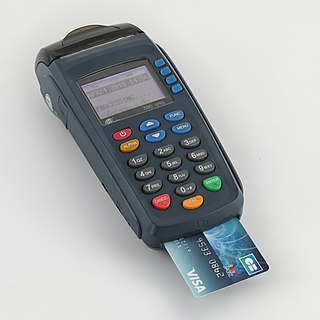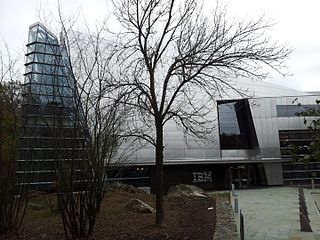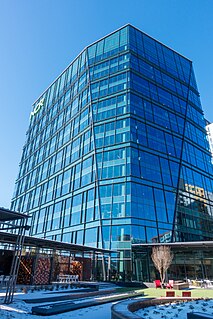In computing, a device driver is a computer program that operates or controls a particular type of device that is attached to a computer. A driver provides a software interface to hardware devices, enabling operating systems and other computer programs to access hardware functions without needing to know precise details about the hardware being used.

An operating system (OS) is system software that manages computer hardware, software resources, and provides common services for computer programs.

In the fields of physical security and information security, access control (AC) is the selective restriction of access to a place or other resource while access management describes the process. The act of accessing may mean consuming, entering, or using. Permission to access a resource is called authorization.

In computing, a web application or web app is a client–server computer program that the client runs in a web browser. Common web applications include webmail, online retail sales, online banking, and online auction.
In computing, an interface is a shared boundary across which two or more separate components of a computer system exchange information. The exchange can be between software, computer hardware, peripheral devices, humans, and combinations of these. Some computer hardware devices, such as a touchscreen, can both send and receive data through the interface, while others such as a mouse or microphone may only provide an interface to send data to a given system.
Open Platform Communications (OPC) is a series of standards and specifications for industrial telecommunication. An industrial automation task force developed the original standard in 1996 under the name OLE for Process Control. OPC specifies the communication of real-time plant data between control devices from different manufacturers.
The OPC Foundation is an industry consortium that creates and maintains standards for open connectivity of industrial automation devices and systems, such as industrial control systems and process control generally. The OPC standards specify the communication of industrial process data, alarms and events, historical data and batch process data between sensors, instruments, controllers, software systems, and notification devices.
CEN/XFS or XFS provides a client-server architecture for financial applications on the Microsoft Windows platform, especially peripheral devices such as EFTPOS terminals and ATMs which are unique to the financial industry. It is an international standard promoted by the European Committee for Standardization. The standard is based on the WOSA Extensions for Financial Services or WOSA/XFS developed by Microsoft.
In computing, Web-Based Enterprise Management (WBEM) comprises a set of systems-management technologies developed to unify the management of distributed computing environments. The WBEM initiative, initially sponsored in 1996 by BMC Software, Cisco Systems, Compaq Computer, Intel, and Microsoft, is now widely adopted. WBEM is based on Internet standards and Distributed Management Task Force (DMTF) open standards:
ASCOM is an open initiative to provide a standard interface to a range of astronomy equipment including mounts, focusers and imaging devices in a Microsoft Windows environment.
In computing, the USB human interface device class is a part of the USB specification for computer peripherals: it specifies a device class for human interface devices such as keyboards, mice, game controllers and alphanumeric display devices.

Apache OFBiz is an open source enterprise resource planning (ERP) system. It provides a suite of enterprise applications that integrate and automate many of the business processes of an enterprise.
UnifiedPOS or UPOS is a world wide vendor- and retailer-driven Open Standard's initiative under the National Retail Federation, Association of Retail Technology Standards (NRF-ARTS) to provide vendor-neutral software application interfaces (APIs) for numerous point of sale (POS) peripherals.

A computer appliance is a computer with software or firmware that is specifically designed to provide a specific computing resource. Such devices became known as appliances because of the similarity in role or management to a home appliance, which are generally closed and sealed, and are not serviceable by the user or owner. The hardware and software are delivered as an integrated product and may even be pre-configured before delivery to a customer, to provide a turn-key solution for a particular application. Unlike general purpose computers, appliances are generally not designed to allow the customers to change the software and the underlying operating system, or to flexibly reconfigure the hardware.

A payment terminal, also known as a Point of Sale (POS) terminal, credit card terminal, EFTPOS terminal, is a device which interfaces with payment cards to make electronic funds transfers. The terminal typically consists of a secure keypad for entering PIN, a screen, a means of capturing information from payments cards and a network connection to access the payment network for authorization.
4690 Operating System, sometimes shortened to 4690 OS or 4690 is a specially designed Point of Sale operating system, originally sold by IBM; however, in 2012 IBM sold its retail business, including this product, to Toshiba, who now supports it. 4690 is widely used by IBM and Toshiba retail customers to drive retail systems running their own applications as well as IBM's Application Client Server Environment (ACE), Supermarket Application (SA), General Sales Application (GSA), and Chain Drug Sales Application (CDSA).
The Media Object Server (MOS) protocol allows newsroom computer systems (NCS) to communicate using a standard protocol with video servers, audio servers, still stores, and character generators for broadcast production.
A trusted execution environment (TEE) is a secure area of a main processor. It guarantees code and data loaded inside to be protected with respect to confidentiality and integrity. A TEE as an isolated execution environment provides security features such as isolated execution, integrity of applications executing with the TEE, along with confidentiality of their assets. In general terms, the TEE offers an execution space that provides a higher level of security than a rich operating system (OS) and more functionality than a 'secure element' (SE).














